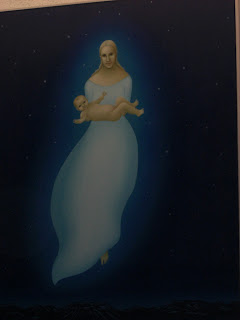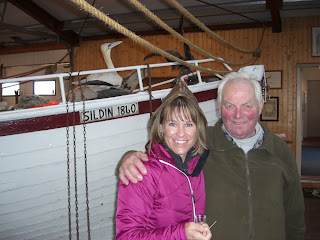After leaving Reykjavík, we made our way north towards the Snæfellness Peninsula and the town of Stykkishólmur. We would spend the next two days exploring the the area and it's many natural sights.
Our first stop was the waterfall near Borgarfjörðour, called Hraunfossar. This was the first of many waterfalls we would see on our trip. It's fed from water coming out of a glacier thru lava flows from a previous eruption.
Adjacent to Hruanfossar is Barnafossar, which flows from the river Hvítá. It takes it name from an old Icelandic saga. According to legend, a husband and wife went to church and told their two boys to stay on the farm. They did not listen and tried to follow their parents to church taking a shortcut over a bridge. They grew dizzy over the bridge and fell into the waters below and drowned. When their mother learned of their death, she put a curse on the bridge that anyone who tried to cross it would meet the same fate as her sons. Later the bridge would be destroyed by an earthquake.
We next made our way to Reykholt and a visit to the Icelandic Settlement Center and a light lunch with some excellent soda bread. The Settlement Center gave us a little information about the original Viking settlers from Norway and the formation of a permanent settlement. The original government was one of tribal chieftains who ruled over various sections of the country. A commonwealth was formed in 930 and the world's first parliament was created. All of these stories were passed down in the oral tradition until they were permanently recorded into stories or sagas.
One of the most important writers of sagas was Sorrí Sturluson. He was twice elected lawspeaker of the country, and was pretty influential until inter-clan feuding took away his power. He was ultimately murdered.
We also made a visit to Deildartunguhver to see the natural hot springs. Because of the volcanic activity on the island, there is an abundant supply of geo-thermally heated water.
The springs at Deildartunguhver are just such an example and significant because the water flows at a rate of 180 liters per second and the water comes out of the ground at 97 degrees Celsius. It is the highest flowing hot spring in Europe.
Steini, our guide, told us that the water coming out of the spring is so clean and clear that is can be used for hot tea. Huge clouds of steam would float over us at the site, which was a great feeling since it was so cold outside. It was so hot it even fogged my glasses.
We rolled into Stykkishólmur in the late afternoon. The city is located on the northern part of the peninsula and has a population of about 1,200 people.
We made a visit to the new church that just opened. It had a beautiful interior, with a nordic themed painting of the Virgin Mary and Jesus above the alter and individual lights hanging down from the ceiling, like stars.
The pastor of the church came out and spoke with us for a bit. He told us about the Church of Iceland and it's Lutheran traditions and how it functions in the reformed faith.
The next morning, we made our way outside the city to Helgafell, or Holy Mountain. It's not really a mountain though. The hill peaks at 240 feet. We were greeted by two sheep at the base of the mountain. They are very used to visitors and came right up to us! I hope they could not sense that I had eaten a lamb dog in Reykjavík!
According to tradition, you have to climb to the 240 foot peak summit without saying a word and facing forward the whole time. Once you make it to the top, you face east and make three wishes. They have to be benevolent wishes though. No wishes of ill will on anyone. You have to keep the wishes secret until they come true and then you can tell everyone!
As you can tell by Marty's huddle, it was very cold and windy at the top, but it sure was a beautiful sight!
Our next stop was the Snæfellsness National Park and the town of Hellnar where we took a nice hike along the cliffs and coast. The park features a diverse array of rock formations.
Towards the end of our walk, Stu had to stop and ponder everything he saw. He was the star on that day because his background in geology made him quite the know-it-all about the various types of rocks and formations we were seeing.
This is me posing in front of Snæfellsjökull, the volcano featured in the Jules Verne story Journey to the Center of the Earth.
One of our most interesting stops that day was to a shark meet processing farm to sample some Kæstur Hárkarl, or "cured" (rotten) shark meat. The meat comes from the Greenland shark, which is fermented and then hung out to dry for four or five months. The meat is toxic when fresh, but once fermented it is fine to eat. Let's just say it's an acquired taste!
It has a particularly strong smell of ammonia and I had to fight the urge to gag when I tasted it. We ate ours on some rye bread and chased it Brennivín, the national liquor of Iceland, which is common since it masks the taste of the shark meat. Brennivín translates to english as "burning wine". With a 37.5% alcohol content, it is affectionately known as "Black Death".
Our guide Steini loved it!
Susan and I were not so sure!!!


































No comments:
Post a Comment